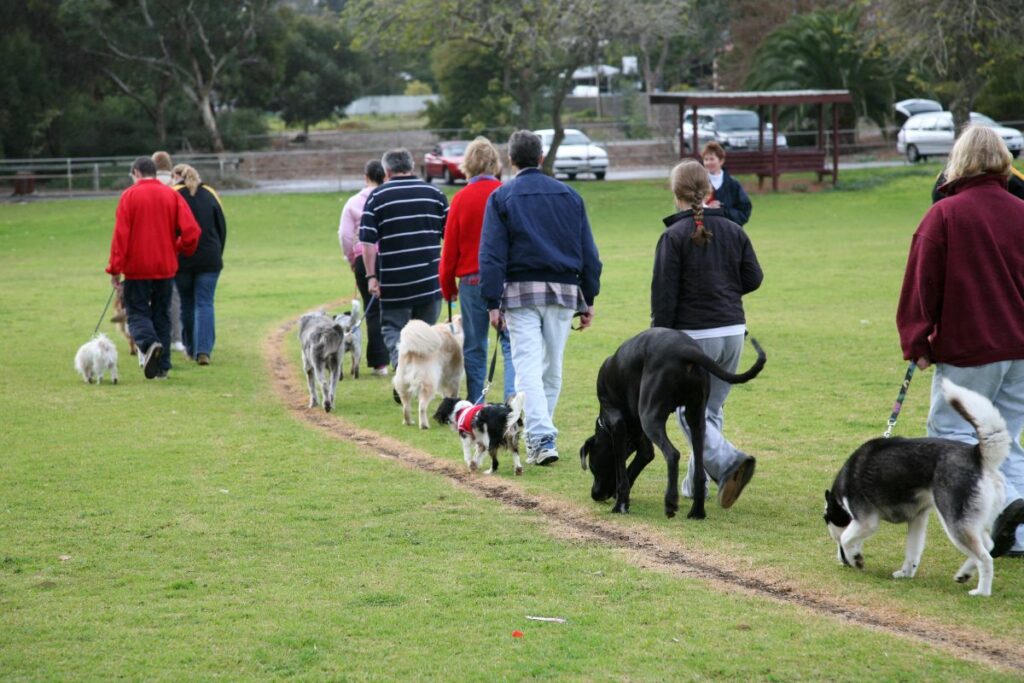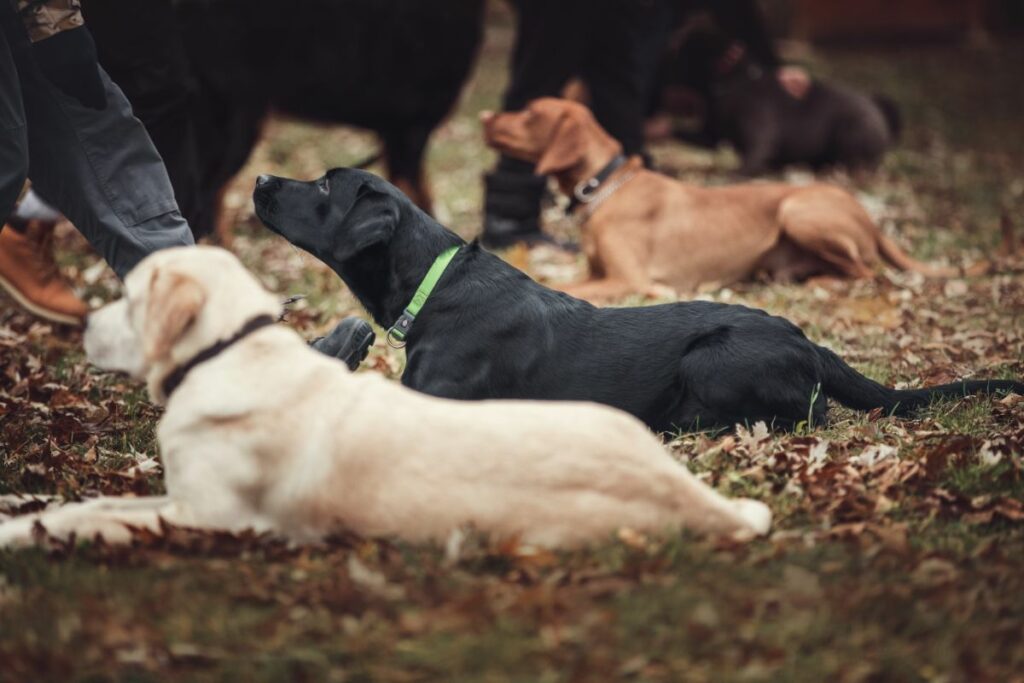You may have taught your dog to sit, stay quiet, shake hands, and more.
But can your dog do these while distracted?

This is one of the reasons many dog owners choose to sign up for group dog obedience training. And it’s not the only benefit, as group dog training can also be a rewarding experience for you as a dog owner.
Still, it can be daunting – especially if your dog is a little harder to control than most other dogs.
So here’s everything you need to know about group dog obedience training, including why it’s important, the pros and cons of group dog obedience training, what to expect during group dog training classes, and more.
What Is Group Dog Obedience Training?
Group dog obedience training is a program of dog training classes performed in a group with other dogs and dog owners.
The classes are structured, often held weekly over the course of one or two months, and led by a professional dog trainer who will help dog owners teach their dogs new behavioral skills, commands, and more.
As the classes are taught in groups, group dog obedience training also helps dogs socialize and interact with other dogs. This can benefit shy or fearful dogs as well as dogs that tend to become overexcited or overwhelmed in the presence of other dogs.
The Importance Of Group Dog Obedience Training
Training your dog to be obedient matters for a number of reasons.
Aside from good behavior at home, group dog obedience training can also improve your dog’s behavior in the outside world, particularly when interacting with other dogs and humans.
Group dog obedience training can help with various behavioral issues, such as aggression, fear or shyness of other dogs, leash pulling, jumping up at people, excessive barking, humping, dog recall, and more.
What To Expect At Group Dog Obedience Training
Firstly, it’s important to know that group dog obedience training is just as interactive for dog owners.
So, while a professional dog instructor is present, group dog training classes are a collective effort where both you and your dog will learn and grow together.
Depending on the length of the program, the dog trainer will help you teach your dog a number of behavioral skills, from learning how to sit to how to behave around other dogs and people.
The group training environment will also provide a higher level of socialization and interaction, which can be more fun for both you and your dog.
The Benefits Of Group Dog Training
There are a handful of benefits to group dog training classes, especially when compared with one-on-one dog training sessions. Some of the main benefits of group dog training include:
- Cheaper: Group dog training is typically cheaper than one-on-one dog training, making it an easy way for dog owners to save money.
- Professional expertise: Dog training is often more effective with professional guidance, making it a faster and easier method of training your dog.
- Dog socialization and interaction: Group dog training classes allow your dog to socialize and interact with other dogs in a safe and fun learning environment.
- Owner learning: Dog owners will also learn a lot from group dog training as the classes are hands-on and interactive.
- Social support system: Group dog training classes can help dog owners befriend other dog owners, providing social support and further opportunities for their dogs to socialize.
The Cons Of Group Dog Training
We can’t talk about the pros of group dog training without mentioning the cons, which are just as important to consider before signing up. Some of the disadvantages of group dog training include:
- Reduced individual attention: As group dog training classes can involve six dogs or more, dogs and dog owners can receive reduced individual attention when compared with one-on-one dog training.
- Less personalized: Group dog training classes involve a “general” curriculum, so not all classes are designed for all skill levels or training needs.
- Distractions: While group dog training classes are designed to teach obedience in a stimulating environment, this can also hinder progress for more disobedient dogs.
- Health risks: Dogs that attend group dog training classes can be at a higher risk of diseases and other health risks, such as fleas.
- Not suitable for all dog breeds: It’s no secret that some dog breeds are more aggressive than others, making group dog training classes less accessible for certain breeds.

Tips For Successful Group Dog Obedience Training
The first step to successful group dog obedience training is finding the right program.
Before signing up, it’s well worth researching your area for all the group dog training classes that are available, what the program involves, and the professional dog trainers themselves.
Before your first class, you can prepare in advance by practicing basic behavioral skills at home. It’s also a good idea to arrive early, which will allow some time for your dog to adjust to the environment.
Last but definitely not least, be patient and enjoy the process!
Conclusion
Group dog obedience training is well worth considering if your dog struggles to behave or positively interact with other dogs and humans.
It can also be a fun and educational experience for you as a dog owner, providing you with a positive environment to teach your dog and meet fellow dog owners.
Group dog training classes offer several benefits over one-on-one dog training, including cost-effectiveness, increased social interaction, and hands-on learning for new dog owners.
So why not try a local class? It might benefit you and your dog for years to come!
Frequently Asked Questions
What Is The Best Age To Start Dog Training Classes?
The best age to start dog training classes is around 8 to 16 weeks. This is considered an important learning stage for puppies.
Despite that, it’s never too late to start training your dog, as dogs can be trained even in their adult and senior years.
Is Group Training Good For Reactive Dogs?
If your dog gets anxious or overwhelmed around other dogs, putting your dog in group dog training classes can do more harm than good, making the training ineffective.
This isn’t true for all dogs, however, as small group dog training classes may still benefit reactive dogs.
- A Guide To Group Dog Obedience Training - August 28, 2023
- A Guide To Total Immersion Board And Train - August 24, 2023
- A Simple Guide On Teaching Your Puppy The Place Command - August 23, 2023
